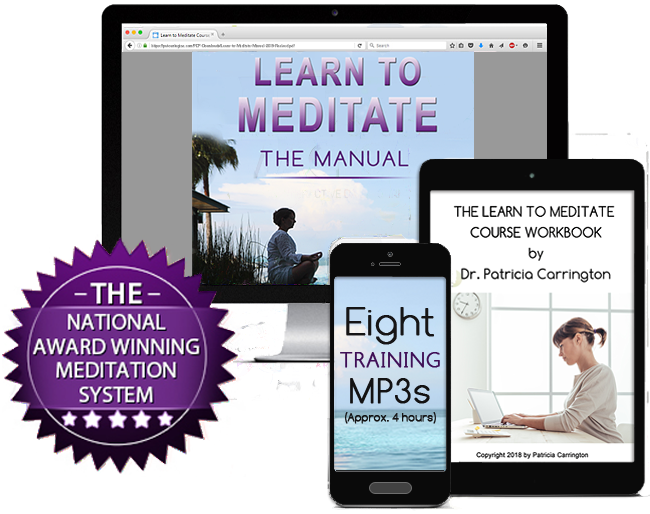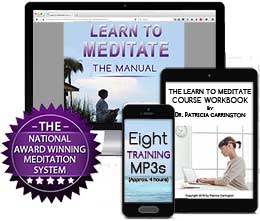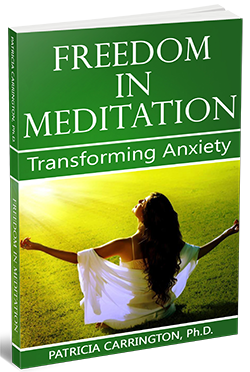Meditating Under Special Circumstances
Patricia Carrington, Ph.D.
Author of “The Book of Meditation”
One of the most common symptoms of anxiety is trouble with sleeping. When we are anxious we are apt to find it difficult to get to sleep or experience sleep as genuinely restful when it comes. We may awaken tired, irritated and tense rather than refreshed. Since meditation often serves to reduce anxiety, does it help to overcome sleeping problems?
It does, although it is not clear what the exact effects are. Together with some of my psychotherapist colleagues, I have treated a number of meditating patients with sleep problems and have noticed that these patients more often than not report improvement in sleep habits after commencing meditation. Sometimes the improvement is dramatic. At the Institute of Living, the researchers found that their meditating psychiatric patients required far less sedation as their chronic insomnia was replaced by a normal, restful seven to eight hours’ sleep. For a number of these meditating patients, in fact, sleeping medications could be eliminated.1 This is a striking effect and coincides with our clinical observations. We so often see improvement in the sleep of patients who commence meditation that I now routinely recommend to any patients who have difficulty sleeping that they try meditation.
|
MEDITATION AUDIO Dr. Carrington explains why, in many instances, meditating helps insomnia and other sleep problems.
|
Improvement in sleep is also one of the benefits of meditation reported by a large number of people who learn the technique and who are unaware of having sleep problems. Researchers Matthew Silverman and Ernest Hartmann sent out a questionnaire to practitioners of Transcendental Meditation (TM) who were not insomniacs or people with particular sleep disorders, but an average sampling of meditators. Many of these meditators reported they were sleeping better and needing less sleep after they had been meditating for at least four months.2
When the same researchers studied eight meditators in the sleep laboratory over a four-month period they found that these people could now fall asleep faster than they could before meditating. While the subjects in this study did not have any particular sleep disturbances to begin with – even before learning to meditate it took them on average only thirteen and a half minutes to fall asleep, a time so short as to be the envy of all those who experience difficulty in falling asleep – after they had learned to meditate even this modest waiting time was reduced. Now on average they required only eight and a half minutes to fall asleep.
Several systematic investigations have been done where meditation has been used with people who actually suffered from insomnia. At the University of Alberta in Canada, researcher Donald Miskiman found that after commencing meditation, people with insomnia could fall asleep more quickly.3 These particular subjects had had so much difficulty in falling asleep to begin with that the change was considerable. Before learning TM it had taken these insomnia sufferers on the average about an hour and a quarter to get to sleep at night. After learning to meditate, they fell asleep within fifteen minutes after lying down in bed.
Such results are not confined to TM. Other forms of meditation work equally well. At Rutgers University a research team headed by psychologist Robert Woolfolk compared three groups of severe insomniacs, people who, on average, took about an hour and a quarter to fall asleep at night and who reported other serious difficulties in sleeping.4 One group was taught progressive relaxation; another, a form of meditation which Woolfolk devised; and the third was not taught any technique.
The technique taught to the meditating subjects was basically the same as the breathing meditation described in Chapter 6 of The Book of Meditation. The only difference is that when they had mastered the meditation itself, Woolfolk’s subjects were then requested to select some specific mental image to focus upon while repeating this exercise.
At the end of four weeks, when the subjects’ daily sleep records were studied, the researchers found that both meditation and progressive relaxation had been effective. The subjects who had practiced these tasks were now able to fall asleep within about a half-hour after going to bed and the whole process was much easier for them. The do-nothing control group’s sleep habits had not changed. What was even more encouraging was the fact that a follow-up study done six months later showed that these gains were not only retained but, if anything, improved. Some subjects had by then even further reduced the time it took them to fall asleep.
Meditation, therefore, seems to be effective in dealing with some of the problems that are major concerns for the mental health professions: persistent anxiety, stress-related illness and sleep disturbances.
Learn about Clinically Standardized Meditation
A Gentle, Easy-to-Learn, Form of Meditation
Dr. Patricia Carrington’s Clinically Standardized Meditation (CSM) is a clinically sensitive meditation method used by numerous medical institutions, organizations, and individuals worldwide.
The main advantages of CSM (and also its difference to other forms of techniques of meditation) are its simplicity, its flexibility and its sensitivity to the individual needs and inclinations of the people who learn it. CSM is extremely permissive, which makes it easier to personalize and internalize the technique and its experience.
1. B. C. Glueck and C. P. Stroebel, ‘Biofeedback and Meditation in the Treatment of Psychiatric Illness’, Comprehensive Psychiatry, 16 (1975), pp. 303–21.A. G. P. Rimol, ‘Transcendental Meditation and its Effects on Sensory and Motor Perception’ (senior thesis, Princeton University, 1974).
2. M. H. Silverman and E. L. Hartmann, ‘Transcendental Meditation and Sleep’ (paper presented before the Association for the Psycho physiological Study of Sleep, Edinburgh, 1975).
3. D. E. Miskiman, ‘The Treatment of Insomnia by the Transcendental Meditation Program’, in Scientific Research on the Transcendental Meditation Program: Collected Papers, ed. D. W. Orme-Johnson and J. T. Farrow (Livingston Manor, NY: Maharishi European Research University Press, 1978) vol. I, pp. 296–300.
4. R. L. Woolfolk, L. Carr-Kaffashan, P. M. Lehrer and T. F. McNulty, ‘Meditation Training as a Treatment for Insomnia’, Behavior Therapy, 7 (1976), pp. 359–65.








